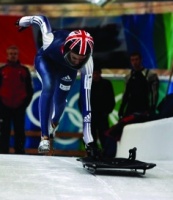Project Blackroc: The gold medal-winning skeleton bob
Partners: Southampton University; British Skeleton Association; UK Sport; Sheffield Hallam University and BAE Systems

For many, it was one of the most thrilling moments of this year’s Winter Olympics: British athlete Amy Williams hurtling head-first down the icy chute of the Whistler bobsleigh track to win the gold medal in skeleton bob — the country’s only medal of the games. Williams’ skill and bravery are beyond doubt, but she was keen to share the credit for her win with the team behind her sled, nicknamed Arthur.
Arthur was the result of the dramatically-named Project Blackroc, a research and development effort bringing in sports scientists from the University of Southampton, expert sliders (as bobsleigh and luge atheletes are known) from the British Bob Skeleton Association (BSA), UK Sport and aerospace engineers from BAE Systems. Designed to build on the success of British sliders in achieving two silver medals in the 2006 Winter Olympics in Turin, Project Blackroc is named after the two Southampton engineers who led the project, Rachel Blackburn and James Roche. Both were employed full-time on the four-year project to develop a sled to maximise the chances of British athletes in the next Games.
Register now to continue reading
Thanks for visiting The Engineer. You’ve now reached your monthly limit of premium content. Register for free to unlock unlimited access to all of our premium content, as well as the latest technology news, industry opinion and special reports.
Benefits of registering
-
In-depth insights and coverage of key emerging trends
-
Unrestricted access to special reports throughout the year
-
Daily technology news delivered straight to your inbox










UK Enters ‘Golden Age of Nuclear’
Apologies if this is a duplicate post - a glitch appears to have removed the first one: > While I welcome the announcement of this project, I note...